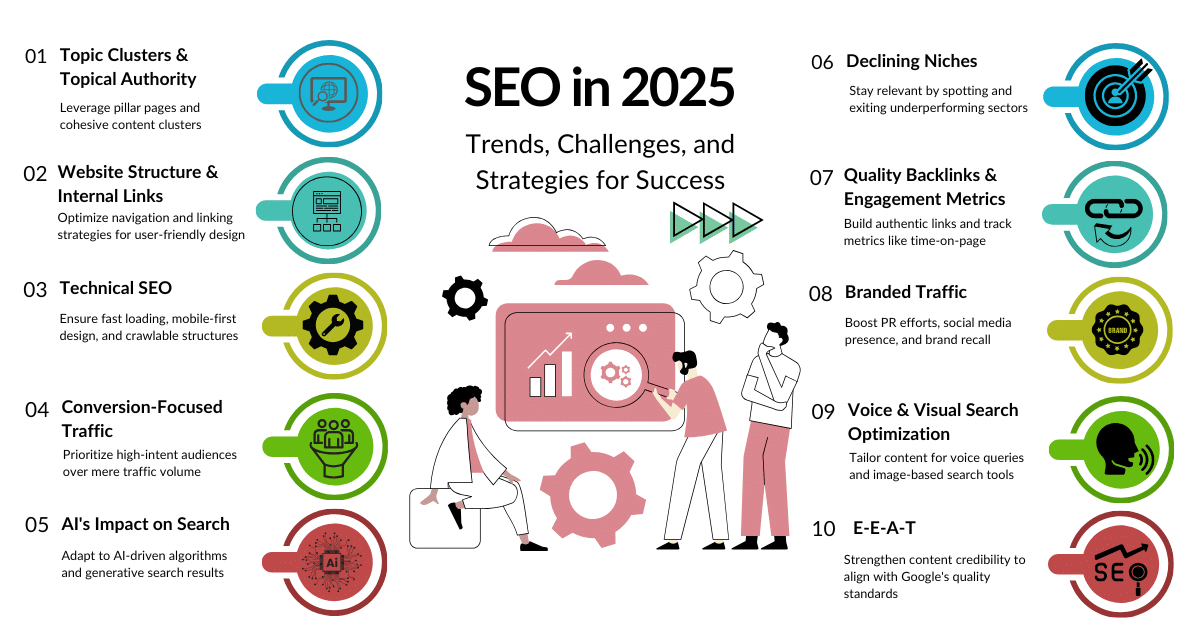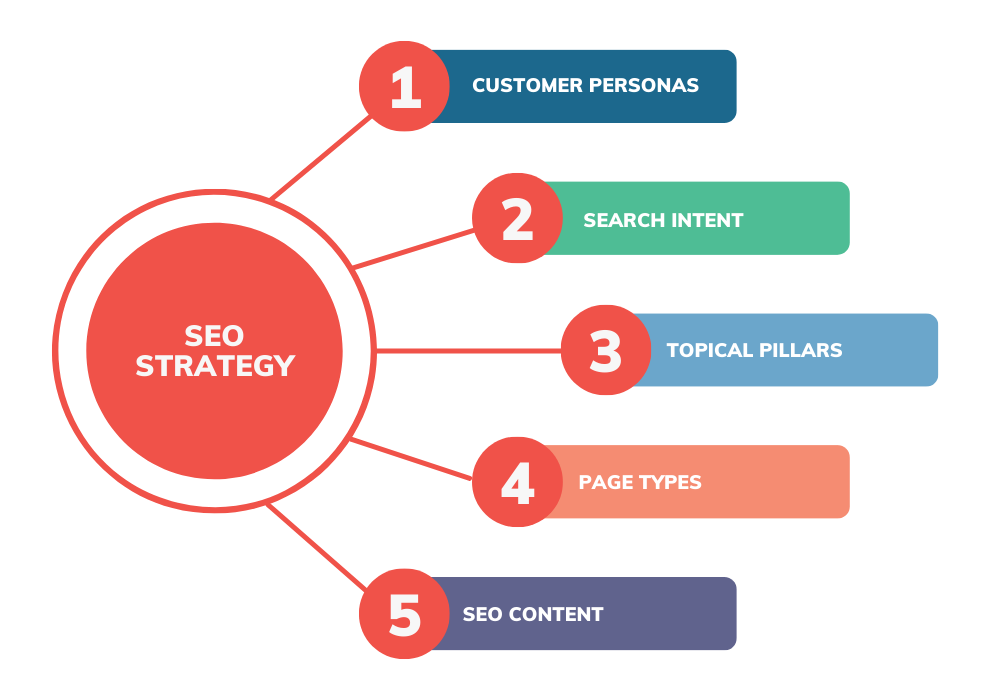A Short Definition
Search engine optimization (SEO) is a set of techniques and strategies that help your website or content show up higher in organic (non-paid) search results on Google, Bing, and other search engines. This boosts traffic, revenue, and brand awareness that are relevant.
Why SEO Is Important
- Organic traffic: getting a steady stream of people who are interested in what you have to offer without having to pay for ads.
- Trust and credibility: People believe in brands that are toward the top of the list.
- Compounding ROI: A solid foundation in your investments will generate profits for you over time.
- Be in the right place at the right time so that people may find you.
The Three Main Parts of Search Engine Optimization
1) On-page SEO
- Finding keywords and making sure they fit with what the person is looking for
- Meta descriptions, title tags, H1–H6 headings, and clean URL slugs
- Experience, Knowledge, Authority, and Trustworthiness (E-E-A-T)
- Adding ALT text to photos, linking to other pages on your site, and using schema markup for articles, FAQs, and how-tos
2) Off-page SEO
- Links from sites that are trustworthy and have to do with what you’re looking for
- Social signals, brand mentions, and public relations
- Citations relevant to your location (for local SEO)
3) SEO for tech
- The speed, stability, and responsiveness of a website are the most crucial factors.
- Design that looks appealing on phones and tablets
- Control of crawling and indexing (robots.txt, XML sitemaps)
- Canonical tags, HTTPS security, and 404/301 redirection
- Schema.org: Data that is structured
How SEO Works (in Simple Words)
- Crawling: Bots look for your pages.
- Indexing: The search index keeps track of everything that is on the site.
- Ranking: The pages that are most relevant and useful come up first. This is where SEO comes into play.
Important Ranking Factors (Highlights)
- Intent match: how deep, effective, and new the content is
- Page experience: load speed, mobile usability, and navigation clarity.
- Backlinks that count and brand power
- Connecting pages and having a decent structure for your site
- Indirect user signals, such as CTR and dwell time
- Local signals (such as Google Business Profile and NAP consistency)
A Step-by-Step Guide to Finding Keywords
- Get the most important keywords for your business or product.
- Find out what the searcher wants: information, a transaction, or help getting around.
- Long-tail keywords are better because they have less competition and get more conversions.
- Refer to the best pages of your competitors and make a plan to perform better.
- Make a keyword map by providing each page a different topic or phrase so that they don’t all fit together.
Samples
- The most important question is, “What is SEO?” “Find out how to make your site better for search engines.”
- Long-tail: “Bengali guide to SEO for beginners,” “Bengali on-page SEO checklist”
A Short List of Things to Do for On-Page SEO
- The title should be no more than 60 characters long, and the main keyword should be toward the start.
- A meta description that is 140 to 160 characters long, action-oriented, and interesting
- example.com/what-is-seo is a clean URL.
- Each page should have one H1 and H2 and H3 for different parts. Add a few different ways to say the word.
- When it’s necessary, write at least 1,200 to 2,000 words.
- Put in 1–2 links to other pages on your site that are related to the issue and 1–2 links to outside sites that are trustworthy.
- Use descriptive ALT text and make images smaller, like WebP.
- Put the schema (Article/FAQ/HowTo) in a place that makes sense.
Things You Need to Do for Technical SEO
- Improve the Core Web Vitals: LCP, CLS, and INP.
- Please ensure that the design functions well on mobile devices and is responsive.
- Pick a reliable host and use HTTPS.
- Please send in the XML sitemaps and double-check that the robots.txt file is set up well.
- You can fix broken links with 301 redirects.
- Canonical tags can help you avoid problems with copying content.
Safe Ways to Build Links and Off-Page
- Content-First PR includes original research, infographics, data studies, and tools.
- High-quality and relevant guest contributions
- A list of resources and outreach for tall buildings
- References and collaborations with brands
- Don’t use spammy links or scams to buy hyperlinks.
Local SEO (If You Work in a Certain Area).
- Make sure your NAP is the same everywhere and fill out your Google Business Profile.
- Please obtain reviews from people in your region and respond to them.
- Use phrases that are specific to your area, such as “dentist in Mirpur” and “SEO company in Chattogram.”
- Make sure to keep your local citations up to date.
Key Performance Indicators (KPI)
- Rankings for keywords and traffic from search engines
- CTR, impressions, leads, and conversions
- PageSpeed, Core Web Vitals, crawl issues, and indexed pages are all important factors to consider.
- The amount and quality of links back to your site.
Essential tools: Google Search Console, Google Analytics 4, PageSpeed Insights, Ahrefs/SEMrush (paid), Screaming Frog
Make a Plan for the First 30 days.
- Days 1–5: Find out what keywords and rivals are out there.
- Days 6–10: Write outlines for both your content and the layout of your page.
- Days 11–20: Post three to five high-quality pillar posts and connect to other pages on your site.
- Days 21–25: Resolving technical issues like speed, mobility, and sitemap/indexing
- Days 26–30: Getting positive links, doing local/PR work, and reporting
Get Rid of These Common Myths
- “Stuffing keywords helps your rank.” It hurts quality and might lower your rankings.
- “All you need are backlinks.” You also need outstanding technology and content that aligns with what you want to do.
- “Once you’ve done SEO, you’re done.” Keep making modifications because algorithms and competitors change.
- “2,000 or more words = auto-rank.” Length doesn’t mean anything is good; it has to be useful and relevant.
A Quick Guide to Small Business Tips
- Please make a separate page for each service.
- To achieve better results, add the FAQ schema.
- Please consider using the “what, why, how, cost, alternatives” format for your blog postings.
- Every month, add 2 to 4 useful articles and 5 to 10 new internal links.
- Once a week, post updates to your Google Business Profile.
Questions and Answers
Q: When will I see results?
A: It depends on the niche and how many people are competing in it. You should see some progress in 3–6 months and more stable progress in 6–12 months.
Q: Are SEM and SEO the same thing?
A: No. There is a difference between organic SEO and paid SEM/Google Ads. In most cases, it is best to use both simultaneously.
Q: Does SEO work for Bengali content?
A: Yes, local SEO, on-page optimization, and Bengali keyword research are all very useful.




